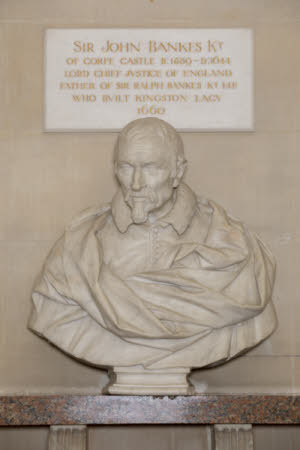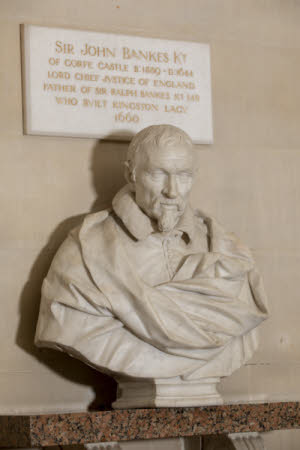Portrait bust of an unknown man
attributed to Alessandro Algardi (Bologna 1598 - Rome 1654)
Category
Art / Sculpture
Date
c. 1645 - 1654
Materials
Marble
Measurements
760 x 760 mm (30 x 30 in)
Order this imageCollection
Kingston Lacy Estate, Dorset
NT 1257591.1
Summary
Sculpture, marble; portrait of an unknown man; attributed to Alessandro Algardi (1598-1654); c. 1645-54. The middle-aged sitter has a moustache and neat small beard; he is dressed in a doublet buttoned up to chin, with a large floppy collar and, over this, a cloak. He looks slightly towards his right and downwards. The bust is mounted on a small integral pedestal. Although the sitter is now unidentified, when the bust was bought for Kingston Lacy by Henrietta Bankes, who added the associated plaque, it was thought to be a portrait of Sir John Bankes (1589-1644). It has more recently been recognised as a fine example of Italian Baroque portrait sculpture and has been attributed to the leading Roman sculptor Alessandro Algardi (1598-1654).
Full description
A portrait bust in marble of an unknown man, attributed to Alessandro Algardi (1598-1654). The sitter, who turns his head slightly towards his right and downwards, appears to be middle-aged, with a moustache and neat small beard, and thin, straggly hair. He is dressed in a doublet buttoned up to his chin, with a large floppy collar and, over this, a voluminous cloak. The bust is mounted on a small integral pedestal. The back is roughly finished, suggesting that the bust was made to be seen essentially only from the front. It was probably therefore made to be displayed in some form of niche, or at least at some height. Above the bust is set into the wall a modern marble tablet with an engraved inscription, gilded, recording the bust as a portrait of Sir John Bankes (1589-1644). Although there is no record of its purchase, this fine sculpture seems to have been acquired by Henrietta Jenny Fraser (1871-1953) later Mrs Walter Ralph Bankes, for display at Kingston Lacy. It is also not known who first identified it as a portrait of the lawyer Sir John Bankes, MP PC (1589-1644), but perhaps its vague resemblance to the two bronze portraits of Sir John made for Kingston Lacy by Carlo Marochetti (NT 1255240.1-2) encouraged this wishful thinking. It has however long been recognised that it cannot be a portrait of Sir John Bankes, who never visited Italy. But the installation of the portrait bust in 1913 in a prominent position in the entrance hall at Kingston Lacy reflects family pride in this distinguished member of the Bankes dynasty, the founder of the family’s fortunes. The subject of the bust is unknown, although it has occasionally been suggested that it could depict the painter Guido Reni (1575-1642), a hypothesis that was rejected by Jennifer Montagu in her discussion of the work. Whoever it may portray, the bust is a very fine example of Roman Baroque portraiture, with the unknown sitter dressed in a doublet, each button carefully carved, and with a wonderfully-sculpted floppy collar. In contrast with this naturalistic and detailed carving, the whole of the bust section is enveloped in a swathe of expansive drapery, in full baroque style. The back of the bust is essentially unworked, indicating that it was made to be seen from the front. It may have been part of some tomb or wall monument, so would have been made for display quite high, a little higher than it is shown at Kingston Lacy. The bust has been associated with the Roman sculptor Giuliano Finelli (1601-1653) as well as his better-known contemporary Alessandro Algardi (1598-1654). In an article published in 1999, the scholar of the Roman Baroque Jennifer Montagu attributed the Kingston Lacy bust more firmly to Alessandro Algardi. Characteristic of Algardi’s style is the brooding and rather serious expression of the sitter, quite different to the more open ‘speaking’ likenesses aimed for in their portraits by Algardi's rivals Finelli and his master Gian Lorenzo Bernini (1598-1680). In addition, the carving of the hair, including the wispy strands across the head and the realistic treatment of the flesh, are also features seen in other portrait busts by Algardi. However, the carving is not in every respect as fine as in sculptures entirely carved by Algardi himself, so it seems likely that there was some participation from his workshop, most probably Domenico Guidi (1625-1701), who worked in Alessandro Algardi’s workshop from 1647. The bust seems stylistically to date from towards the end of Algardi’s career, making it entirely feasible to suggest that Guidi assisted with its execution. Jeremy Warren May 2023
Provenance
Probably acquired by Henrietta Jenny Bankes (1871-1953); installed in entrance hall, 1913; by descent; bequeathed by (Henry John) Ralph Bankes (1902-1981) to the National Trust, together with the estates of Corfe Castle and Kingston Lacy and its entire contents, in 1981.
Marks and inscriptions
Inscription on tablet above bust:: SIR JOHN BANKES KT. OF CORFE CASTLE B: 1589 – D: 1644 LORD CHIEF JUSTICE OF ENGLAND FATHER OF SIR RALPH BANKES KT. M.P. WHO BUILT KINGSTON LACY 1660
Makers and roles
attributed to Alessandro Algardi (Bologna 1598 - Rome 1654), sculptor
References
Dombrowski 1997: Damian Dombrowski, Giuliano Finelli. Bildhauer zwischen Neapel und Rom, Frankfurt-am-Main 1997, pp. 266, 428, cat. No. F. 144, Abb. 256. Montagu 1999: Jennifer Montagu. “A mysterious masterpiece: a bust by Algardi at Kingston Lacy.” Apollo 149 (April 1999), pp.14-15. Montagu 1999: Jennifer Montagu, ed., 'Algardi. L’altra faccia del barocco', exh. cat., Palazzo delle Esposizioni, Rome 1999, no. 51. Giometti 2010: Cristiano Giometti, Domenico Guidi 1625-1701. Uno scultore barocco di fama europea, Rome 2007, pp. 25-27, fig. 9.





